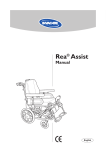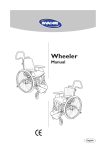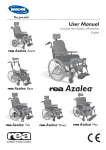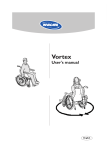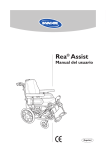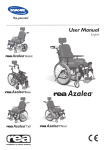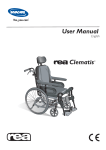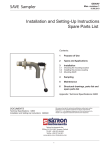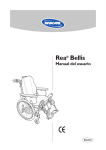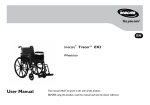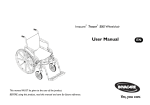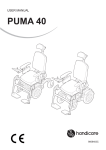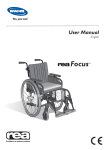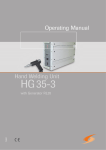Download 1428232 Comfort eng pass 04-12-13
Transcript
Rea® Comfort Manual English Contents Product description NB Delivery check Daily performance check Intended use Parts of wheelchair Lifting the wheelchair Standard equimpment Upholstery and frame colours Accessories Technical data Assembly Adjustments Seat Legrests/footrests Footplates/calf pads Backrest Armrests Seat unit User and carer operated chair Electrically operated chair Charging the battery Rear wheels plate adjustment Carstors Wheelchair heights Brake Carer- operated brake Push bar/Push handles braced Anti-tip devices Accessories Headrest/Neckrest Abduction cushion Trunk support Transport Transport of wheelchairs in vehicles Observations Restraint methods Safety instructions/propelling techniques Guarantee Recycling 2 3 4 5 5 5 6 6 7 7 7-8 8 9-10 11-21 11 11-12 12 13-14 14 15 16 16 17 18 18 19 19 20 21 21-22 23 23-25 26-27 28 29 30 31-32 33 34 REA® COMFORT Product description Rea® Comfort Rea® Comfort is a wheelchair with many adjustment options and accessories.To ensure that you benefit as much as possible from Rea® Comfort, and in order to do its options justice, the chair must be tested and adjusted by competent personnel. We hope that you have also received instructions for using your Rea® Comfort in everyday life. This manual includes a description of the parts of the chair, simple adjustment options, how to use the Rea® Comfort safely and how to transport it. The manual must be read thoroughly before the chair is used. Also included in this manual is a description of how all accessories are fitted and slightly more advanced settings. As the Rea® Comfort has many different components and accessories, the appearance of the accessories you have for your chair may differ from those shown. The Rea® Comfort’s wheels, seat frame, legrests, push handles and certain other components subjected to strain are made of steel. Backrest rails are made of high quality aluminium. The frame’s jointed parts are made of polyamide reinforced with fibreglass. Footplates and side supports are made of reinforced plastic. The seat plate is made of wood and the backrest plate is made of wood and the upper part of plastic. Plastic details are marked for recycling. Seat and backrest cushions are made of polyether and the upholstery is made of washable plush or elastic polyurethane cloth. The Rea® Comfort is a manual wheelchair with an angle-adjustable seat unit. The angle of the backrest unit can be adjusted independently of the seat. The seat and backrest controls can be operated manually or electrically by the user or by the carer. The Rea® Comfort is available in three widths. The seat depth, backrest height, armrest height, armrest depth, legrest height and legrest angle of each chair can be adjusted. The height of the chair can also be altered. The rear wheels are 24” or 22”, the castors are 120 mm-200 mm. The wheels can be pneumatic or semi-solid, with or without a carer-operated brake. 12” transport wheels can be chosen, with or without a carer-operated brake. The seat and backrest cushions are designed to provide good stability and comfort for the user as well as good pressure distribution. REA® COMFORT 3 NB! This symbol means warning. Here below a number of points affecting your personal safety are shown. Read it carefully! Invacare is only responsible for product changes carried out by personnel who we authorise. We reserve the right to make any changes to equipment and specifications without prior notice. Failure to comply with instructions given may result in personal injury and/or product damage. • • • • • • • • • • • • • • 4 Check each of the following before using the wheelchair: – that all parts are attached securely to the frame – that all wheels, knobs, scews and nuts are properly tightened. – that all brakes and anti-tip devices function correctly Never lift the wheelchair by the detachable armrests, footrests, backbrace or by the adjustable push handles. Always apply the brake before getting into or out of the chair. Never stand on the footplates when getting into or out of the chair, because of the risk of tipping. Changing the seat angle gives an increased risk of tipping over. The handrims may become hot due to friction, which may cause injury to your hands. Use extensively the anti-tip device Remember that the effectiveness of the carer-operated brake is reduced in wet and slippery conditions, as well as when on a slope. Be careful to ensure that the rearwheels are securely attached. There is a risk of tipping and injury if the velcro straps on the backrest become too slack. Always check the tension. Surfaces of the wheelchair like frame parts or upholstery, with long time sun shining on them, can reach temperature > 41 degrees C. When mounting accessories etc. be careful not to trap your fingers. There is always an increased risk of trapping parts of your body when tilting the wheelchair’s back and seat. The width of the seat should never be adjusted so much so that the inside of the armrests press against the side of the pelvis. REA® COMFORT Delivery check Any transport damage must be reported immediately to the transport company. Remember to keep the packaging until the transport company has checked the goods and a settlement has been reached. Daily performance check Check that the following parts are still currently assembled on the wheelchair: • Wheels • Backrest • Anti-tip device • Push handles • Footrests Intended use • The Rea® Comfort is a manual wheelchair, intended for users who can propel the chair to a certain extent and operate the angle adjustment themselves, and who remain seated for long periods. Rea® Comfort’s comfort and stability as well as the option of adjusting the angle of the seat unit and backrest comprise an ideal combination for activity and comfortable rest. • Regarding both operation and adjustment of seating position, the Rea® Comfort is intended for operation by the user or carer. However, the user must be fully aware of the effects of changes made. • The Rea® Comfort is mainly intended for indoor use for which we recommend 120-140 mm castors. For outdoor use we recommend 140-200 mm castors. • The Rea® Comfort must be used with its seat and backrest pads. • Max. user weight is 125 kg • The service life of the chair depends on its application, the user’s degree of activity as well as care and maintenance. REA® COMFORT 5 Parts of the wheelchair 2 4 12 5 3 14 7 1 10 11 6 1. 2. 3. 4. 5. 6. 7. 8. 9. 10. 11. 12. 13. 14. 8 9 13 Backrest Push handle Neckrest Armrest Rear wheel Rear wheel plate Anti-tip device and step tube Brake Castor Seat Legrest Handle for backrest angle adjustment Knob for seat tilt Allen key for adjustments (on back of backrest cushion) Always lift the wheelchair by gripping the frame at the points shown in the diagram. Never lift the wheelchair by the removable armrests or the foot-rests. Ensure that the backrest and push bar are securely in place.Also read the chapter Safety instructions/propelling techniques. 6 REA® COMFORT Standard equipment Seat width 39,44 or 49 cm Seat depth 42.5 or 45 cm Backrest height 62,5 + 20 cm without seat cushion Upholstery and frame colours Upholstery Grey Plush, TR32 Grey Dartex, TR23 Frame colours Pearl Grey Accessories Rea® Comfort has a wide range of accessories and options. Some of the accessories may not be available in all countries. Backrest type Backrest plate Backrest tension adjustable Backrest cushion Laguna (lateral support) Mistral 2 (waist support) Passad 2 (shoulder support) Shoulder High 05 Vicair Multifunctional Cover Thin, 04 Cover, Lateral 05 Backrest cover REA® COMFORT Seat Standard Seat cushions Tromb (positioning support) Bris (preventive) Vicair Multifunctional Seat and backrest angle Carer- or user operated Electrically operated by carer/user adjustment Legrests Angle adjustable Fixed 80 degrees Legrest amputee Footrests Fixed footplate Angle-adjustable and depth-adjustable Foot plate extender Heel strap Armrests Height adjustable armrest Hemiplegic Autolock armrest Castors 120–200 mm, pneumatic or solid, wide or narrow 7 Rear wheels 12", 22", 24", pneumatic or puncture-proof Brakes User brake Hand operated assistant brake Others Several types of hand rim Reflector Kit Table Tray Pump Cane holder Headrest Headrest with cheek support Neckrest Push bar Push handles braced Pelvic Belt Abduction cushion Incontinence cover Trunk support Technical data – Rea Comfort 39, 44, 49 cm 42,5–50 cm 37,5–47 cm 62,5+20 cm 23–34 cm (without seat cushion) 33–50 cm -2°– +20° 34 kg (seat width 44) max 125 kg Seat width + 25,5 cm 90 cm 119 cm transport weight 16,5 kg Tie down point* Crashtested *Our wheelchairs comply with ISO norm 7176-19 and have been tested in a basic configuration. The use in other configurations has not been tested. See section "Test report from dynamic safety restraint test", for test configuration.Wheelchair users should however transfer to the vehicle seat and use the vehicle installed restraint system whenever it is feasible. 8 REA® COMFORT Assembly 1. When you receive your wheelchair, you must fit the backrest, armrests and legrests onto the chair. The assembly is simple and does not require any tools. 1. Backrest The backrest is fitted onto the wheelchair by feeding the shafts (A) of the backrest onto the tubes of the chair (B). Ensure that you push the backrest down as far as possible. Secure into place by tightening the knobs (C). Secure the backrest pad using the Velcro strips. A Now check that the backrest is secured firmly in position! C B 2. D 3a. REA® COMFORT 2. Armrests Attach the armrests by feeding them into the attachment (D) at the sides of the wheelchair. Push them downwards until you can feel that the armrests are securely in place. 3 Legrests/footrests The wheelchair can be equipped with either legrests or footrests. 3a Legrests Attach the legrests by pushing the tube at the upper part of the legrests down into the tubes on the wheelchair. You must angle the legrests outwards when inserting them. 9 Lock the legrests by turning them inwards.The legrests are automatically locked so there is no risk of them coming off the wheelchair. 3b. 3b Footrests Attach the footrests by pushing the tube at the upper part of the footrests down into the tubes on the wheelchair. You must angle the footrests outwards when inserting them. Lock the footrests by turning them inwards.The footrest are automatically locked so there is no risk of them coming off the wheelchair. 4. B 4. Attach the rear wheels by pressing button (A) in the centre of the hub whilst simultaneously sliding the axle (B) into the rear wheel position attachment of the positioning plate. It is very important that you check that the locking pin has actually locked the wheel into position when the centre button has been released. Take hold of the wheels and try to detach them. This should NOT be possible. A 10 REA® COMFORT Adjustments SEAT 1. 1. The seat cushion is secured with Velcro strips on the seat extender. 2. You can adjust the depth of the seat by removing the seat cushion and loosening the screws (A) with an Allen key, moving the front edge of the seat forwards or backwards, and then re-tightening the screws. The distance between the hollow of the knee/calf and the cushion is to be as short as possible, but without contact. Replace the seat cushion. 2. Tool: 5 mm Allen key A SLIDING SEAT (ACCESSORY) The sliding seat is a great help to the user when moving into or out of the chair. The user must sit in the chair when the seat is moved forwards. Pull the lever (A) upwards at the same time as you pull the handle (B) and move the seat forwards. B A Remember that the sliding seat increases the seat height by about 3,5 cm. When you adjust the seat only use the handle. LEGRESTS/FOOTRESTS 1. The legrest can be adjusted forwards or backwards to suit the leg length. When positioned correctly, the legrest can be angled upwards without the user’s knee being raised. A Tool: 5 mm Allen key REA® COMFORT 1. Adjust the depth of the legrests by removing the screws (A) using an Allen key. Adjust to the required depth and re-tighten the screws. Use a different set of holes in the legrest attachment to fit the legrest further forwards or backwards. 11 2–3. It is important to adjust the legrests, footrests, footplates and calf pads to obtain a good seating position. B 2. Legrests height adjustment Adjust the height of the legrests by loosening the screw (A) one turn with an Allen key. Pull the legrest until you have obtained the correct height and the screw is caught by one of the recesses on the legrest tube. Then retighten screw. A 3. Legrests angle adjustment The angle of the legrest is adjusted using the handwheel (B). Loosen the handwheel approx. one turn. The angle can be set in intervals from 80° to 0°. Retighten the handwheel when the correct angle is obtained. The distance between the lowest part of the footrest and the surface must be at least 40 mm. Tool: 5 mm Allen key 4. 4. Footrests height adjustment Adjust the height in the same way as the legrests above. NOTE! Don't touch the upper screw (C). C A The distance between the lowest part of the footrest and the surface must be at least 40 mm. Tool: 5 mm Allen key FOOTPLATE/CALFPAD 1. 1. Angle-adjustable footplates Adjust the angle and the depth by loosening the screw (A) at the footplate attachment with a 5 mm Allen key. Adjust the footplate to the correct position and retighten the screw. Do not place anything on the footplate when the screw is loose. A Tool: 5 mm Allen key 2. D B C Other pin positions can be used if there is a risk that the user could injure themselves, just adjust the footplate to a more suitable position, 2. Calf pads The calf pads can be fitted in four different depth positions. Swing the pad forwards. Unscrew screw (B) using an Allen key. Remove the large nut (C) on the reverse side and place it in the other attachment hole. Move the calf pad to the new position and secure it into place with the screw. Tool: 5 mm Allen key 12 The height of the calf pads can easily be adjusted using the handwheel (D). REA® COMFORT BACKREST 1. Backrest plate 1. You can easily adjust the backrest plate (+ 10 cm) by loosening the two upper screws (A) with a 5-mm Allen key. Set at the required height and re-tighten. A 2. 2. The upper section has two height levels and is as well removable. ( For lower backrest cushions) Loose screws (B) with an 5-mm Allen key and raise it to its heighest position. For removal, remove the screws (B). B 3. Tension adjustable 3. For raising the height (+12,5cm), loose screw (A) and lift the backrest frame up. A REA® COMFORT 13 4. 4. For shaping the form, loose the Velcro straps, tighten first where you would like to have a firm support and follow with the others. Check that the cover/cushion do not "lock" the straps by the Velco attachment. Please ensure that the velcro straps are not too loose, as this will result in your back coming into contact with backrest bow (A), and could result in injury. Backrest cushions The three backrest cushions support waist,shoulders or latheral , and all of them fits on the backrest plate and the tension adjustable back. Note that they should as well as the covers for tension adjusable back cover the upper part of the backrest tube. ARMRESTS Armrest height 1. Adjust the height of the armrests by turning the knob or Allen key screw (A), setting the required height and then re-tightening the knob/screw. 1. A Armrest depth 2. You can also adjust the depth of the armrest pad. Loosen the knob (B), set the pad in the required position and re-tighten the knob. 2. B 14 REA® COMFORT Seat unit USER-OPERATED ANGLE ADJUSTMENT 1. The entire seat unit can be tilted backwards to provide a more relaxed position (resting), or forwards for a more active position at mealtimes or when moving into or out of the chair, for example. The angle of the backrest unit can be adjusted independently of the seat unit. F 1. Tilt the entire seat unit by turn the knob (F) until you attain the required seating position. 2. 2. Adjust the backrest angle by pulling the handle (B) whilst pushing the backrest away from you or leaning forwards slightly. B CARER-OPERATED ANGLE ADJUSTMENT 1. The wheelchair is equipped with carer-operated controls. You can adjust the angle of the backrest forwards or backwards and tilt the whole seat unit including the backrest. These two functions can either be controlled manually or electrically. Be careful when adjusting the angle of the backrest so that you do not trap your or the user’s fingers between the backrest and the armrest. 1. Tilt adjustment Tilt of the seat unit (seat and backrest) by pulling the left-hand lever (C) upwards and keeping it there whilst you tilt the seat unit to the required position. Release the lever (C). C 2. 2. Backrest angle adjustment Adjust the angle of the backrest by pulling the right-hand lever (D) upwards and keeping it there whilst you push the backrest away from you or pull it towards you until you have obtained the required position. Release the lever (D). D REA® COMFORT 15 ELECTRIC TILT AND BACKREST ANGLE ADJUSTMENT 1. B C 1. Tilt adjustment Tilt the seat unit (seat and backrest) by using the lower part of the control panel. Press (B) to adjust the angle of the seat unit backwards or press (C) to adjust the angle forwards. The hand control should only be used by authorised personell. The risk of trapping fingers, etc, is greater in electric adjustments than in user-operated adjustments. Bear in mind, for example, that a child may get hold of the controls and get trapped, or trap the user. 2. B C 2. Backrest angle adjustment Adjust the angle of the backrest by using the upper part of the control panel. Press (B) to adjust the angle of the backrest forwards or press (C) to adjust the angle backwards. The risk of trapping fingers, etc., is greater in electric adjustments than in user-operated adjustment. Bear in mind, for example, that a child may get hold of the control box, press the controls and get trapped, or trap the user The hand control should only be used by authorised personnel.. CHARGING THE BATTERY 3. 3. Charging the battery If your wheelchair has electrical angle adjustment the battery needs to be charged. If the angle adjustment function has been used during the day, it is a good idea to leave the charger on overnight. Charge the battery by plugging the battery charger supplied with the chair into a wall socket.Then connect the charger cable to the output on the side of the control box. It takes about 12 hours to charge a battery that has been used 50% of its capacity. Work on the handset should only be carried out by properly trained personell. 16 REA® COMFORT REAR WHEELS PLATE ADJUSTMENT 1. You can adjust the height of the seat by moving the rear wheel plate upwards or downwards. The balance of the wheelchair can be adjusted by moving the rear wheel attachment forwards or backwards.When the attachment is moved forwards, the chair will be somewhat easier to propel, but the risk of tipping will increase. If you move the attachment towards the rear, however, the chair will be more stable but slightly harder to propel.Test the different settings to see what suits you best. B Tool: 24 mm fixed spanner 2. 1. Horizontal position Loosen the rear wheel housing (B) with a spanner. Move the housing to the required position, either further forwards or backwards. Ensure that you tighten the housing securely when you have decided on the position. A Now check the position of the brakes, and that the user can move the chair safely in its new balance position. A A Tool: 10 mm fixed spanner REA® COMFORT 2. Height See the height table for correct positioning. Loosen and remove the nuts (A) using a spanner. Also remove the spacers between the cross tubes (B) and the nuts. Then move the rear wheel plate to the height required, and then retighten the nuts (A). 17 CASTORS Remove the castor (+castor fork) by pressing the button (A) and then pulling the wheel (with the castor fork) straight downwards. Check the castor is securely fitted after replacement. A WHEELCHAIR HEIGHTS REA® COMFORT 37,5 39,5 42 42 44,5 44,5 22” 22” 22” 22” 22” 22” 4 3 2 2 1 1 3 3 1 2 1 120 150/140 150/140 180 200 39,5 39,5 42 42 44,5 44,5 47 24” 24” 24” 24” 24” 24” 24” 4 4 3 3 2 2 1 2 3 1 2 1 120 150/140 150/140 180 200 47 24” 1 2 3 150/140 180 2 3 1 150/140 180 180 2 200 WHEELCHAIR HEIGHTS REA® COMFORT TRANSPORT 44,5 44,5 18 12” 12” 1 200 2 3 150/140 180 REA® COMFORT BRAKES Start by checking that the tyres have the correct air pressure (printed on the side of each tyre). 1. A 2. A C B 1. User brake Apply the brake to the chair by pulling the lever towards you. The user brake is to be used when the chair is not moving, and is not intended for reducing speed when the chair is moving. To apply the brake, move the lever (A) forwards. To release the brakes, move the lever towards the rear (towards you). Be careful that you do not trap your fingers between the brake pin and the tyre. 2. To attain the correct braking effect, the brake pin should press into the tyre when you apply the brake. The brake may therefore require depth adjustment. Loosen the screw (A) and move the brake attachment to the required position. Retighten the screw (A). There should be a distance of approximately 15 mm between the pin (B) and the tyre (C). Tool: 5 mm Allen key Incorrect setting or use of the brake reduces the braking effect. CARER-OPERATED BRAKE 1. 1. Braking when moving: squeeze both brake handles upwards, and the brake will be applied. 2. 2. Locking the brakes: squeeze the handle and move the lock catch (A) upwards. Then release the handle. A 3. 3. Releasing the brakes: squeeze the handle and the lock catch will release automatically. Incorrect setting or use of the brake reduces the braking effect. REA® COMFORT 19 PUSH HANDLES BRACED/PUSH BAR 1. A 1. Push bar/Push handles braced Loosen the knobs (A). The height of the pushhandles braced/pushbar can be adjusted simply by pulling the handles upwards or pushing them downwards. Adjust it to the height that you require and tighten it. It is important that you do not mix up the upper and lower knobs on the back of the backrest. The lower knobs lock the backrest to the chair, and if these are loos ened by mistake, the safety of the chair may be jeopardised!. Do not touch these knobs! 19 cm 20 The pushbar/pushhandles braced must not be pulled up so that it protrudes more than 19 cm over the top edge of the attachment. Do not trap your fingers between the push handles brace and the neckrest attachment. (If you have tension adjustable.) REA® COMFORT ANTI-TIP DEVICES 1. The anti-tip device also acts as a step tube. It is heightadjustable and easy to adjust. A 1. Press the spring-loaded buttons (A), raise or lower the anti-tip device and ensure that the springloaded buttons (A) pop out into place properly in their new position. A 2. 2. Fold the anti-tip device under the wheelchair by pressing the spring-loaded buttons (A), turning the anti-tip device to the required position, ensuring that the buttons (A) pop out again into position. Never forget to fold down the anti-tip devices. Accessories HEAD REST 1. 1. The height respectively the removale is operated by the handwheel (A). The bar is equiped with a "memory" stoy. Loose screw (B) and adjust, retighten. B A 2. 2. The angle and depth is adjusted by the two screws (C) and the handle (D). Loosen, adjust and retighten. C D REA® COMFORT 21 3. 3. The sidewise adjustment is made by loosening screw (E). Adjust and re-tighten. E 4. 4. The angle of the wings is adjustable by loosening screws (D). Adjust and re-tighten. D NECK REST 1. 1. The height respectively the removale is operated by the handwheel (A). The bar is equiped with a "memory" stoy. Loose screw (B) and adjust, retighten. B A 2. C 2. The angle and depth is adjusted by the two screws (C) and the handle (D). Loose then and adjust. D 22 REA® COMFORT ABDUCTION CUSHION 1. 1. The height adjustment and removal is operated by the handwheel (A). A 2. The depth is adjusted in a forward or backward position. Loosen handwheel (A) and turn. 2. A TRUNK SUPPORT 1. TRUNK SUPPORT Multi adjustable 1. You adjust their height by first loosening the screws (A) whilst moving the attachment (B) upwards or downwards.Re-tighten the screws (A). B A 2a. 2a. Remove the cover and see illustrations to the left for suggestions of: • heigt and depth adjustment 2b. 2b • angle REA® COMFORT 23 2c. 2c • small side support / large trunk support Alt.1 • large side support / small trunk support Alt.2 G I H Tool: 5 mm Allen Key screwdriver TRUNK SUPPORT The trunk supports can be adjusted in height,depth and sideways. 1. You adjust their height by first loosening the screws (G)whilst moving the attachment (H)upwards or downwards.Re-tighten the screws (G). 2. You adjust the trunk supports sideways by loosening the knob (I), moving the support sideways to the required position and then re-tightening the knob (I). 3. To adjust the depth of the trunk supports,first unzip the trunk support cover to reveal the screws inside.Unscrew them using a screwdriver, and move the trunk support forwards or backwards. Retighten the screws and zip up the cover. 4. Remove the trunk support by loosening knob (I) and pulling the trunk support sideways and outwards. Be careful not to trap your arm between trunksupport and armrest when changing the angle of the backrest. 24 REA® COMFORT 1. TRUNKSUPPORT Swing away It is possible to adjust the height, depth and sideways position of the trunk support. 1. Adjust the height by first slackening the Allen screws (A) while simultaneously moving bracket (B) up or down. Re-tighten Allen screws (A). Tool: 5 mm Allen Key 2. 2. The sideways position of the trunk support is adjusted by slackening the three screws (C). Next, move the support sideways until the desired position is found and re-tighten screws (C). 3. 3. In order to adjust the depth of the trunk support; first undo the zipper on the support, to expose the screws (D). Use a screwdriver to slacken these and slide the trunk support backwards or forwards. Re-tighten the screws and do up the zipper. 4. 4. The trunk support can be folded away so that they do not obstruct the user when he or she gets into or out of the chair. REA® COMFORT 25 Transport The Rea® Comfort is easy to prepare for transport. 1. Backrest Remove the back cushion by pulling it forwards, thus separating the Velcro straps. Loosen both knobs (A) and pull the backrest directly upwards. Lay the backrest on the seat, where it can remain during transport of the wheelchair. Where applicable, detach the push handles. Be careful with the cables that run from the rear wheel to the push handles. When detaching the backrest and placing it on the seat, try to make sure that the cables hang freely. 1. A B 2. 2. Push handles braced. Loosen the two knobs (B). The height of the handles can be adjusted simply by pulling the handles upwards or pushing them downwards. It is important that you do not mix up the upper and lower knobs on the back of the backrest. The lower knobs lock the backrest to the chair, and if these are loosened by mistake, the safety of the chair may be jeopardised! Do not touch these knobs! The pushhandles braced must not be pulled up so that it protrudes more than 19 cm over the top edge of the attacthment. 3. Legrests The legrests are loosened by pushing the lever (C) forwards whilst turning the legrests outwards. You can then simply lift off the legrests. 3. C 4. Footrests The footrests are loosened by pushing the handle (D) forwards or sidewards whilst turning the footrests outwards.You can then simply lift off the footrests. 4. D 26 REA® COMFORT 4. 4. Armrests, Pull them staight up 5. 5. Rear wheels Remove the rear wheels by pushing buttom (A) and pulling the wheel straight out. A REA® COMFORT 27 Transport of wheelchairs in vehicles The Rea® Comfort has been tested for safety in collisions according to ISO 7176-19:1997. The Rea® Comfort can be used for transport in vehicles that have been specially adapted for this purpose. The wheelchair must be securely fastened in the vehicle according to the methods described on the following page. Remember that the best solution is always to move the user from the wheelchair into a normal car seat. TEST REPORT FROM DYNAMIC SAFETY RESTRAINT TEST Test no: Date: T0051 16/6/98 Customer: Invacare Rea AB Test no: Date: P300998B 19/02/03 Customer: Invacare Rea AB Pulse specification Wheelchair Testing to be carried out ISO/CD 7176-19-1 (January 97), frontal collision (Rea® Comfort) ISO-7176-19 and ISO-10542, frontal collision (Rea® Comfort Transport) Weight: Configuration: Invacare Rea AB Rea® Comfort and Rea® Comfort Transport 34,5 kg Forward facing Manufacturer: Model: Attachment device: Configuration: Unwin Safety Systems WWR/ATF/K/R and WWR/HD/ATF/K/R Unwin Low Profile Rail 4 Pt. Restraint User safety belt: Manufacturer: Model: Unwin Safety Systems 3-Pt QIR/3H/ATF/WH Testdummy Hybrid III Weight: Wheelchair Safety restraint device Test configuration Manufacturer: Model: Chassie: Backrest: Seat: Armrest: Legrest: Rear wheel: Castor: Accessories: Tested: 76 kg 44 / 44 Backrest 96 / C11 Laguna Bris Height adjustable AA Alu / AA Steel 24" pneumatic / 12” pneumatic 200 x 30 mm / 200 x 45 nn Calfpads, Heel straps / Neckrest, 1998-06-16 / 2003-02-19 The safety restraint devices used in this test must be approved according to ISO10542. We have chosen to work with Unwin, a well-known quality manufacturer of safety restraint devices for wheelchairs. 28 REA® COMFORT OBSERVATIONS BEFORE TRANSPORT OF WHEELCHAIRS IN VEHICLES • We recommend that wheelchair users should transfer to the seat of the vehicle and use the installed restraint system of the vehicle whenever feasible. • The wheelchairs are tested in a basic configuration. The use in other configurations has not been tested. See user manual, section "Test report from dynamic safety restraint test", for test configuration. • Auxiliary wheelchair equipment is either secured to the wheelchair or removed from the wheelchair and secured in the vehicle during transit. (i.e. table trays, etc.). Pommels and crotch straps are not recommended during transport as they can cause injury to the groin and genitals if the vehicle brakes suddenly. • Alterations or substitutions are not to be made to points of the wheelchair or to structural and frame parts without the written consent of Invacare®. • A wheelchair-anchored pelvic belt must be fitted across the wheelchair occupant in addition to the lap and diagonal and restraint (3-point belt). • Belt restraints are not to be held away from the body by wheelchair components or parts such as armrests, postural restraints, wheels, etc. (See illustration below.) • The wheelchair must be securely fastened in the vehicle with an ISO 10542-2 approved 4-point belt system, according to the methods described in the manual. • The occupied wheelchair must be tied down in an forward-facing configuration, with the parking brake applied. • The test dummy weight is 75 kg, according to ISO 7176-19, although the chairs are approved for users up to 125 kg.. • The wheelchair backrest should be positioned as close as possible to 90 degrees. • If possible, a headrest should be used during transit, in order to reduce the risk of neck unjury. The headrest should be placed as high as possible. Please observe that even if these products and recommendations are provided in order to increase security and safety, injury to vehicle occupants still might occur in the event of a collision or other accidents and no guarantee is given in this respect. Correct placement of belt REA® COMFORT Incorrect placement of belt 29 RESTRAINT METHODS Rea® Comfort B C A. Frontal restraints with straps 1. Connect the frontal straps around the main frame of the wheelchair. 2. Release brakes and tension front straps by pulling the wheelchair backwards from the rear. Re-apply wheelchair brakes. B. Rear restraints 1. Attach the snap hooks on the rear straps to the vertical rear frame, just above the horizontal rear frame. 2. Tighten the straps. C. Fastening of pelvic belt and safety belt 1. Check that the pelvic belt on the wheelchair is correctly fastened. 2. Fasten the 3-point safety belt over the user. If pelvic belt on the wheelchair is missing we recommend that the user should transfer to the seat of the vehicle, if possible A The safety belt should not be kept from the user’s body by the parts of the wheelchair. Rea® Comfort Transport B C A. Frontal restraints with straps 1. Connect the frontal straps around the main frame of the wheelchair. 2. Release brakes and tension front straps by pulling the wheelchair backwards from the rear. Re-apply wheelchair brakes. B. Rear restraints 1. Attach the snap hooks on the rear straps to the vertical rear frame, just above the horizontal rear frame. 2. Tighten the straps. C. Fastening of pelvic belt and safety belt 1. Check that the pelvic belt on the wheelchair is correctly fastened. 2. Fasten the 3-point safety belt over the user. A If pelvic belt on the wheelchair is missing we recommend that the user should transfer to the seat of the vehicle, if possible The safety belt should not be kept from the user’s body by the parts of the wheelchair. 30 REA® COMFORT Safety instructions/propelling techniques We recommend that you have the chair tested by the qualified person who has prescribed the wheelchair, after he or she has made the adjustments that you request, taking your build and needs into account. We hope that you have also received help in learning how best to use the wheelchair. Start by practising carefully until you are familiar with the wheelchair’s possibilities and limitations. Move to/from the wheelchair Propel the wheelchair as near as possible to the seat that you want to move to. Apply the brake. Remove the armrests or move them upwards out of the way, and detach the legrests or swing them outwards. Do not support yourself on the footplates as this may cause the chair to tip forwards. Stretching and leaning Propel the wheelchair as near as possible.When stretching and bending, do always have full contact between the backrest and the back otherwise the wheelchair may tip over. Stretching behind the back is not recommended. Propelling up a slope Many experienced users can propel themselves up a slope. In order not to lose control of the steering and to avoid tipping backwards, you should always lean forwards whilst propelling up a slope. Propel the wheelchair forwards using short, quick strokes applied to the hand rims, in order to maintain speed and steering control. Generally, help is needed on steep slopes. If you have to stop on a slope, it is particularly important to ensure that you do not make any sudden or unexpected backward movements when you start moving the wheelchair forwards again. As the wheelchair is already leaning backwards, such a movement may cause the wheelchair to tip backwards.The maximum gradient of slopes that can be attempted is varied between 3° and 13,5° depending on the user weight and the adjustments of the wheelchairs. Propelling down a slope We recommend that you obtain the help of one or more assistants when going down steep and wet slopes. First check the slope to see if there are any particular hazards, potholes, slippery sections, etc. Never use the user-operated brake to slow down.When you apply the brake on a downward slope, the wheels lock and the wheelchair can suddenly pull to one side, tip sideways or stop immediately, which may cause you to be thrown out of the chair.Always control the speed with the hand rims. Remember that the hand rims may become hot due to friction, and this may cause injury to your hands. Try to propel down the slope in a straight line as much as possible. REA® COMFORT 31 Climbing a kerb This method is for when the assistant is always behind the wheelchair and it creates the greatest safety for the user. The following advice is for the assistant: Illustration 1) Adjust the anti-tip devices upwards. Ensure that the user’s feet rest securely on the footrests and cannot slide off.Then tilt the wheelchair backwards and push it forwards against the kerb. Illustration 2) Lower the frontal part of the wheelchair onto the pavement and place yourself as close to the chair as possible, before you lift up the whole wheelchair. Illustration 3) Lean forward and lift/roll the wheelchair over the pavement edge. Illustration 4) Lower the wheelchair onto the pavement so that the weight is divided on all four wheels. Ensure that the wheelchair does not roll backwards. Dismounting a kerb Follow the procedure above, but in reverse order (step 4, 3, 2 and then 1) to move off a kerb. Kerbs – alternative method This method is generally used by experienced assistants who are stronger than average. It can also be used when the kerb or step is low and only constitutes a minimal obstacle. The assistant steps backwards onto the pavement and pulls the wheelchair up onto the pavement. It is important for the assistant to use his or her body correctly to prevent injury.Tip the wheelchair backwards and roll the chair over the kerb onto the pavement. Take particular care if the kerb is wet or slippery. Escalators Do not use escalators when you are in the wheelchair. Find out whether there is a lift nearby. Stairs We advise you to avoid using stairs when you are in your wheelchair, where possible. Choose an alternative route instead. We recommend that you receive help from two assistants to get up and down stairs. One assistant walks in front of the chair holding the frame of the wheelchair, whilst the other assistant walks behind the chair, holding the push handles. Check that the push handles/push bar are securely fixed in place before you start. Fold the anti-tip devices upwards. Balance the wheelchair on the rear wheels until the balance point is found. The wheelchair is then rolled down the stairs, step by step, by letting the rear wheels roll over the edge of each step. Assistants must not lift by gripping the removable armrests or legrests. They must remember to lift the chair at the correct points, to use their legs and to keep their backs as straight as possible. 32 REA® COMFORT Guarantee We provide a three-year guarantee from the delivery date. Damage due to wear and tear on upholstery, tyres, (rubber) tubes, hand rims and castors, for example, is not covered by the guarantee. Damage that has been caused though physical violence or abnormal use is not covered. Damage caused by users who weigh more than 125 kg is not covered. The guarantee will only apply if the care and maintenance instructions are followed. Maintenance instructions Your Rea® Comfort wheelchair is easy to keep clean. Cleaning Wipe metal parts and the upholstery regularly with a damp cloth. A mild detergent may be used. If necessary, the upholstery can be washed at 40ºC. Normal washing powder/liquid may be used. Wheel and tyres • Wheel axles are to be wiped clean and lubricated with a drop of oil. • Pneumatic tyres have a car tyre valve and can be pumped up using the same type of pump that is used for cars. Recommended air pressure for rear wheels: Standard tyres 3.5 bar 50 psi Low profile tyres 7.0 bar 90 psi Recommended air pressure for castors: (200 mm) 8” 4.0 bar (150 mm) 6” 2.5 bar Technical servicing • Only original parts, or those approved and complying with Invacare’s specifications, may be used. • All technical servicing must be carried out by an authorised wheelchair technician or by Invacare’s® service department. The address and telephone number are on the back cover of this manual. • Examine all parts of the wheelchair once a week to check for cracks or other damage. If you discover damage, please contact Invacare immediately. The address and telephone number are on the back cover of this manual. • Screws and nuts are to be checked regularly and tightened securely (this applies to all loose parts). Service life We estimate that the Rea® Comfort has a service life span of 5 years. It is difficult to state a precise service life span for our products. The stated period is an estimation of average life span based on normal use. This life span may be considerably longer if the wheelchair is used to a limited extent, and if it is used with care, maintained and handled properly. The life span may be shorter if the wheelchair is subjected to extreme use. Accidents/Near-accidents Please inform your Invacare office immediately of any accidents or near-accidents that have been caused by this wheelchair and that have led to, or could have led to, personal injury.The relevant authority must also be contacted and reported to. Testing The Rea® Comfort has been tested and approved by The Swedish Handicap Institute and is CEmarked according to the Medical Device Directive. REA® COMFORT 33 Recycling The wheelchair Rea® Bellis can be divided into the following main components: • Chassis • Plastic parts • Upholstery • Wheels, tyres and tube • Packing Chassis The chassis is produced in steel and is fully recyclable. Recycling of steel requires only 20-25% of the energy compared to new produced steel. Comfort has two gas pistons and they contain oil and must be disposed according to national requirements Be aware of that the gas pistons contains high pressure and must be handle with care during destruction. Plastic parts The plastic parts in the chairs are produced of "Thermoplastic" and are marked with recycling symbols (where it is possible due to part size).The main plastic material is polyamide.This material can be recycled or burned in approved facilities. Upholstery Upholstery is produced of polyester fibres, PUR or PVC. The efficient way to recycle the parts is to burn them in approved facilities. Wheels, tyres and tubes • The hand rim, rim, spokes and hub are made of steel, stainless steel or aluminium and can be recycled according to above. • Tyres and tubes are made of rubber and can be recycled according to above. Packing All Invacare Rea AB packing material is developed to fit the products in an optimal way to reduce unnecessary material waste. All boxes are recyclable. Contact your local recycling agent to otain the correct information on how to handle the above mentioned materials. 34 REA® COMFORT Manufacturer: Invacare Rea AB Växjövägen 303 S-343 71 DIÖ SWEDEN Sales companies: Denmark: France Germany: Austria, Switzerland and Eastern Europe Invacare GmbH Kleiststraße 49 D-32457 Porta Westfalica Tel. +49 - 57 31 754 0 Fax. +49 - 57 31 75 45 21 91 Invacare A/S Sdr. Ringvej 39 DK-2605 Brøndby Tel. +45 - 36 90 00 00 Fax. +45 - 36 90 00 01 Invacare Poirier S.A.S Les Roches F.37230 Fondettes Tel. +33 - 02 47 62 64 66 Fax. +33 - 02 47 62 64 10 Holland: Italy: Invacare B.V. Celsiusstraat 46 / P.O. Box 123 NL-6716 BZ Ede Tel. +31 - 318 695757 Fax. +31 - 318 695758 Invacare Mecc San s.r.l. Via dei Pini, 62 IT- 36016 Thiene VI Tel. +39 - 445 380059 Fax. +39 - 445 380034 Norway: Portugal: Invacare AS Grensesvingen 9 N-0603 OSLO 6 Tel. +47 - 22 57 95 00 Fax. +47 - 22 57 95 01 Invacare Lda Rua Senhora de Campanhâ 105 PT-4369-001 Porto Tel. +35 - 12 510 59 46 Fax. +35 - 12 510 57 39 Spain: Sweden and Finland: Invacare n.v. Autobaan 14 B-8210 Loppern, Brügge Tel. +32 - 50 83 10 10 Fax. +32 - 50 83 10 11 Invacare S.A C/Areny, s/n Polígon Industrial de Celerá S- 17460 Celrá (Girona) Tel. +34 - 972 493200 Fax. +34 - 972 493220 Invacare AB Fagerstagatan 9 / Box 66 S-163 91 Spånga Tel. +46 - 8 761 70 90 Fax. +46 - 8 761 81 08 United Kingdom and Ireland: Invacare (UK) Ltd. South Road, Bridgend Industrial Estate Bridgend County Borough of Bridgend CF31 3PY United Kingdom Tel.: +44 1656 664 321 Fax.: +44 1656 667 532 Art.nr. 1428232 041213 Belgium:




































